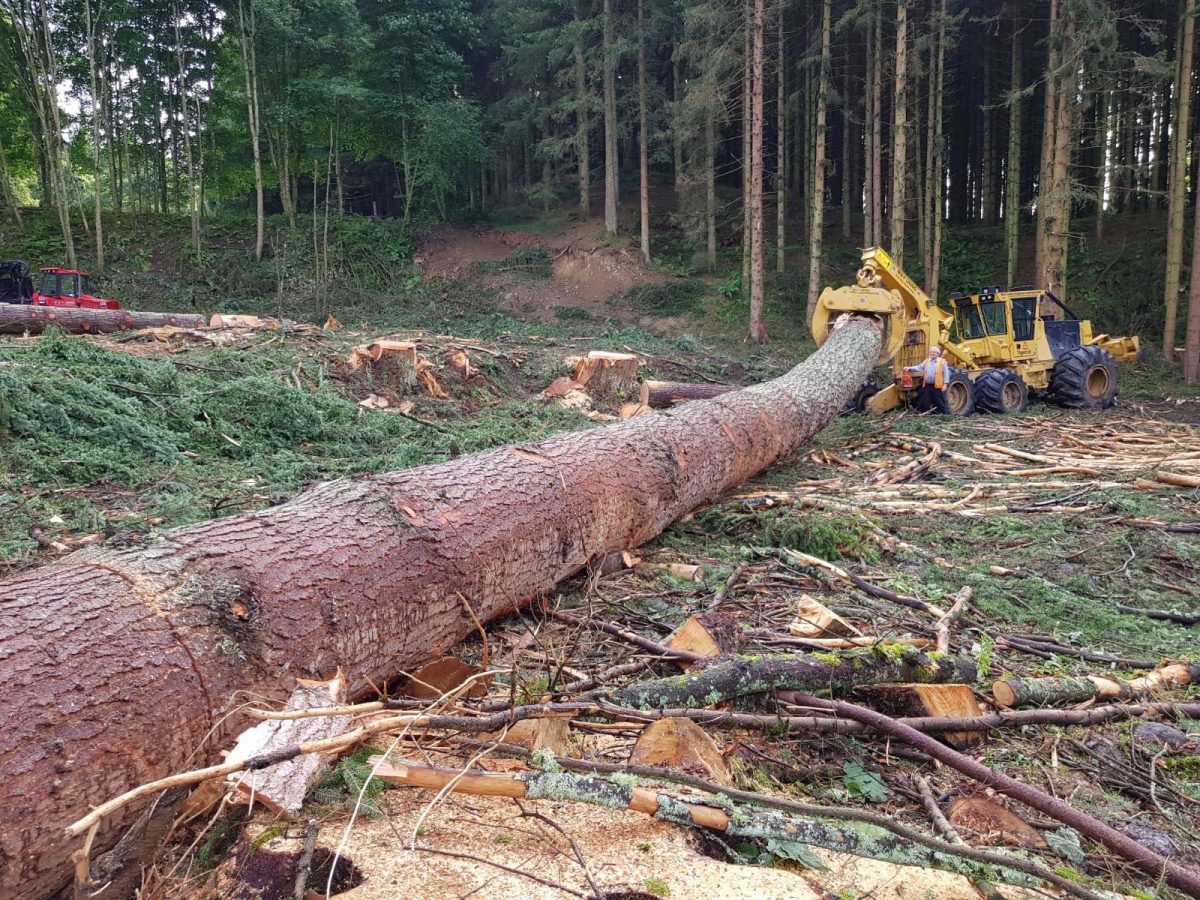A Cut Above
Looking back, one of the favourite parts of my forestry career was felling big trees. This will probably piss off the tree huggers and snowflakes big time, but, hey ho, who cares about their uneducated opinions. If these people actually read a dictionary and found out what the word sustainability means, then they might learn something regarding forestry and how it works. Perhaps if these idiots would stop shouting about deforestation and listen for a change, they might find that commercial forests all over the world are in effect largely increasing in size year on year rather than decreasing. Indeed, rather than destroying it, sustainable forestry is helping to heal our planet and improve air quality. The big trees I have felled over my career have either been commercially grown softwoods for the timber products they yield or individual trees that have been deemed a hazard by local authorities.
W&V Laing Timber Contractors are one of the few tree specialists that have the necessary equipment for felling and extracting large and awkward trees. I was thrilled when Willie phoned to let me know he was starting a mature oak thinning near Perth using his Tigercat 615E grapple skidder and his Komatsu 895 forwarder. I was looking forward to seeing Willie and his team and I had been assured I would get to try out both machines for myself.
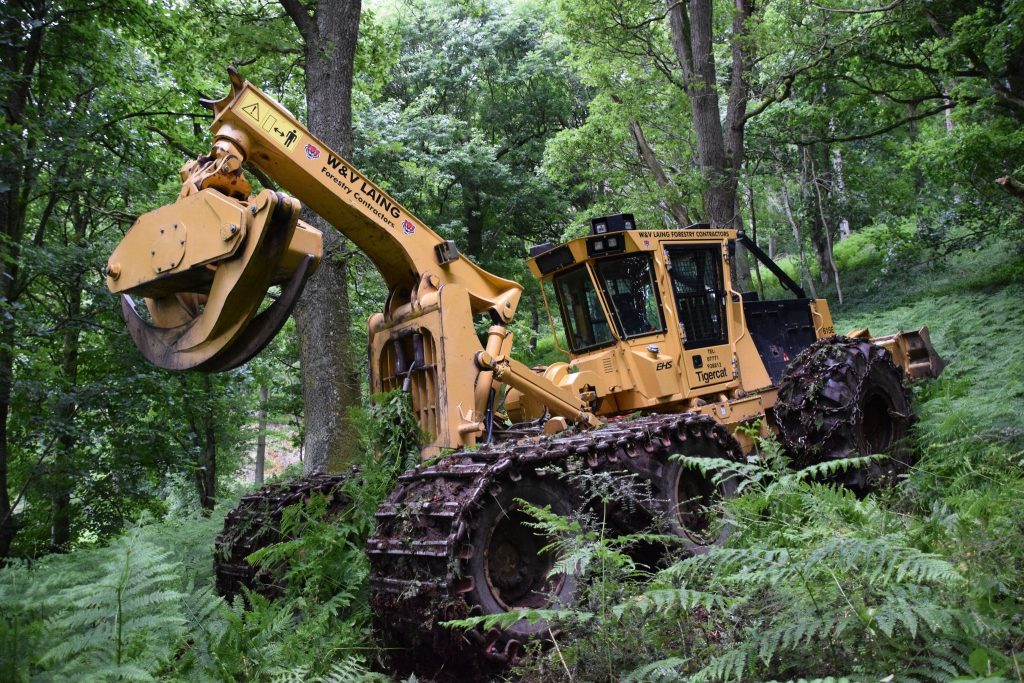

Willie was working on a private estate with approximately 70 large trees that required felling and extracting. The branches and crooked timber were to be cut into 3m lengths for firewood, while the straight stems would be used for sawn timber, beams or veneer. This site was being worked for Chantler Timber from Crewe, the largest purchasers of round hardwood timber in Britain. The company purchase both standing and felled hardwoods and softwoods, and Willie is employed to fell and extract many of their standing timber sites. This site predominantly consisted of mature Oak and the trees to be removed had to be felled and extracted without damaging the remaining crop.
Willie was working along with two others – Tommy Garrow, who alternates between his own tree surgery work and working with Willie, and Willie Carrie (or Willie C to prevent any confusion). Willie also has one other employee – Jimmy Garrow (Tommy’s father) – who works full-time operating a Komatsu 875 forwarder extracting behind a harvester.
The trees were reasonably close to the forest road we had to access the site and were being felled away from the road into gaps in the woodlands. It has been a long time since I have felled any large hardwoods, but it was obvious that Willie and his team had planned the felling of each tree meticulously and that their years of experience shoe through.
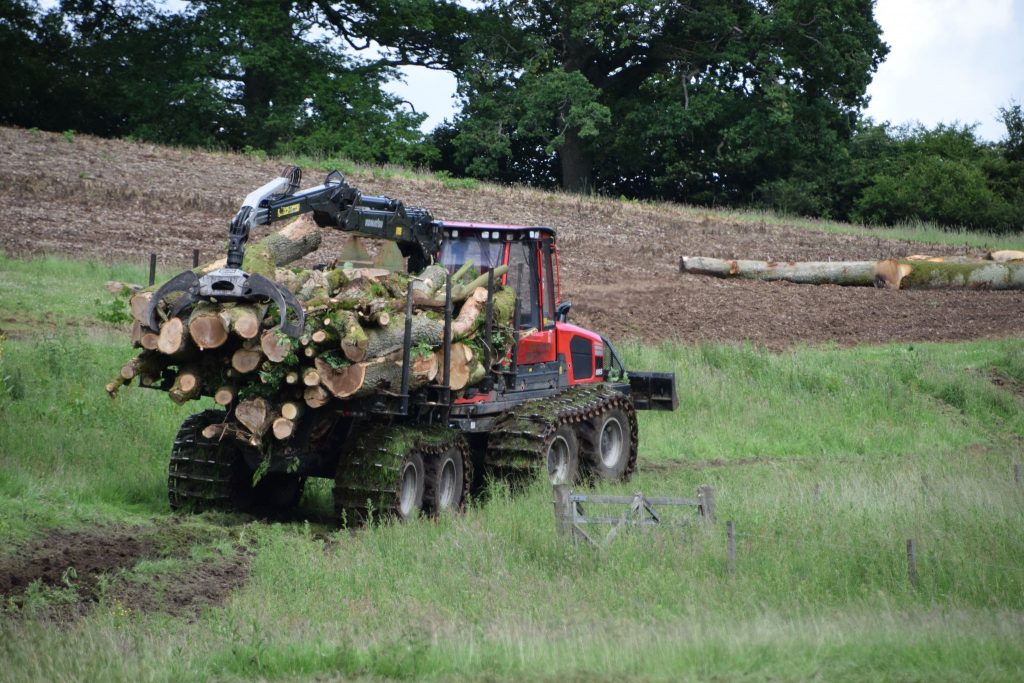

Felling each tree was a challenge. The 20 tonne hydraulic winch on the Tigercat made sure each tree went in the direction it was supposed to. Tommy attached a Dyneema strop about 10m up the stem, which was joined to the winch cable and tightened before felling commenced. This wasn’t as straightforward as it sounds as the Tigercat had to be manoeuvred into position to ensure it had a straight, unobstructed pull without damaging any trees yet remained outside the risk zone.
When I saw the Dyneema strop I was dubious about whether it was strong enough, but Willie confidently informed me it had a 50 tonne breaking strain. I found it difficult to believe this soft, flexible strop had over double the strength of the 19mm steel winch cable.
Once the Tigercat was in position and the winch was attached to the tree and tensioned, Tommy operated the skidder while Willie felled the tree using his Husqvarna 395 chainsaw. After the felling cut and back cut were completed, Willie moved well out of the way and then gave the signal for Tommy to operate the winch; the tree had no option but to fall in the direction it was being winched, hitting the ground with an almighty clatter.
Once Willie C had uncoupled the strop so it could be winched out of the way, he and Tommy set about de-limbing and crosscutting the branches with their Husqvarna 572 chainsaws while Willie went to get the Komatsu 895 forwarder.
Willie C started at the bottom and Tommy at the top of the tree; they could see each other and took it in turns to remove a limb off the trunk, meaning only one chainsaw was working on the tree at a time. This way, if the tree turned or moved, only one person was actively cutting and the other operator was clear.
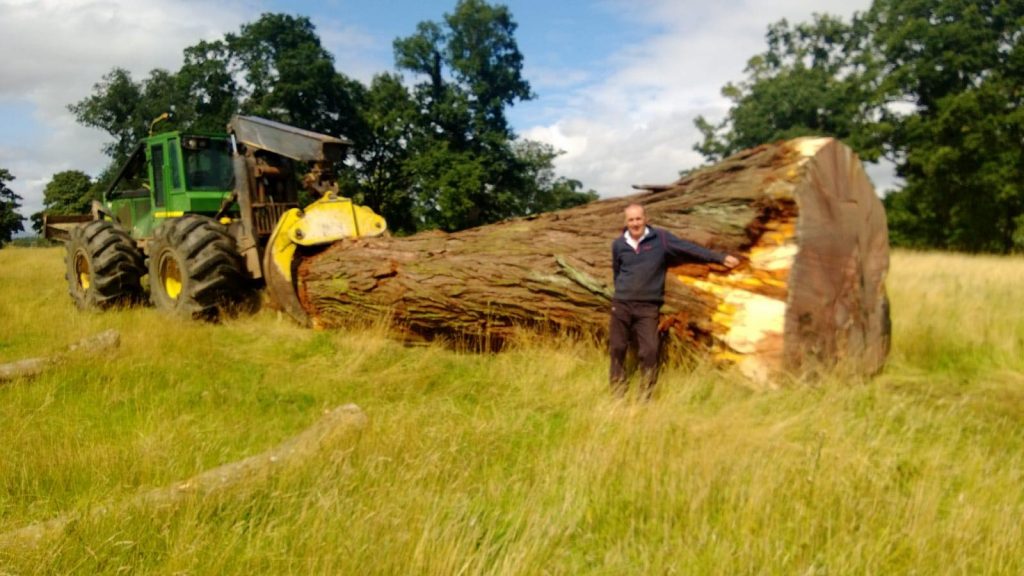

Once a few limbs were removed and cut to length they both moved out of the way; the forwarder then entered the fray, stacking and loading the produce and clearing the branches out of the way before the chainsaws recommenced. This happened two or three times until just the main stem was left, with the surrounding area clear of brash. The brash had been scattered and then driven over to break it down as the forester wanted it left in the woods to decompose. A good team working safely in harmony is a pleasure to watch and it was surprising just how quickly they processed the big Oak tree.
While Willie C and Tommy set about stropping the next tree to be felled, I was told it was my job to move the Oak trunk out of the way with the Tigercat skidder. I was looking forward to my first ever drive of a Tigercat and I think the 615E was a pretty good starting place.
Although the cab is surprisingly roomy and the vision out of the rear and sides is good, the forward view isn’t great. There is not much you can do about this as you are looking out over the bonnet and blade. Willie has fitted a camera on the front with a fairly large screen in the cab and this has substantially increased vision.
The controls are well laid out and easy to understand. The comfortable seat has two joysticks: one to drive and steer the skidder and the other to operate the grapple. The turnaround seat locks in two positions – to the rear and forward – and it rotates 90°-100° as opposed to 180° like a forwarder. The operator is never square onto the windows; this means when facing forward you have to strain your neck to look out to the left hand side of the skidder and the opposite is true when facing backwards.
The terrain was steep in places so the skidder was fitted with band tracks and wheel chains; although the ground was firm the top surface could become very greasy in wet conditions. The Tigercat was very responsive on the steering and felt stable when traversing any side slopes or driving over obstacles. Once direction of travel is selected with the toggle on the joystick and the brakes are released, it is a case of touch the foot throttle and go.
The EHS transmission is a dream to use and is computer controlled. It has two drive motors which give high tractive effort when under load; however, when travelling empty or loaded on flat conditions one drive motor goes offline and the hydraulic oil is directed to the working motor to increase travelling speed.
So far so good – now all I had to do was reverse up to the tip of the Oak saw log and open and lower the grapple to pick it up. The grapple is easy to control with the multi-function joystick, each movement is incredibly smooth and precise. The log was at a right angle to the direction I wanted to go so once in the grapple Willie had suggested I drive straight forward and then reverse and turn before heading out of the forest. By carrying out this manoeuvre the log was well clear of damaging any standing trees – the last thing I wanted to do was to tarnish Willie’s excellent reputation. Despite what was a fairly severe slope to ascend, it was effortless for the Tigercat and even in the greasy conditions there was no wheelspin. Looking around the site there was literally no ground damage, just a few marks where the logs had been dragged during extraction.
I released the log and manoeuvred the skidder back down the slope and into position to winch the next tree over. Operating the Tigercat was a fantastic experience and I was surprised just how agile and light footed it was for quite a big machine.


After the next tree was on the ground, I got the chance for a chat with Willie. We are both the same age and have similar years in forestry under our belts. Willie started out as a gamekeeper for the first three years of his working life before joining the FC at Drummond Hill, Loch Tayside. Initially, he was with the planting squad and after a month moved over to the skyline squad where he worked for the next six years. He decided to leave the FC to establish his own forestry company, which he has built up ever since. Willie is quick to point out that this is not all his doing as his wife Violet has been a driving force in the success of the business. Violet has experience in forestry in her own right and also started out as a skyline operator.
Earlier in his career Willie identified a niche in forestry and got out of mainstream harvesting to specialise in working with large trees. His first big skidder was a Clark Ranger which he thought was an excellent tool for the work he was carrying out, and after a few years he decided to upgrade to a newer machine.
He had seen a John Deere 648 skidder for sale overseas – there are few big skidders working in the UK and hardly any available for sale – so he went out to see if it was suitable. The trial only took place in a yard so he didn’t get the chance to see it working properly. The deal was completed nonetheless and the machine was imported to the UK and it was only when he started using it that he realised the grapple didn’t lift as high as the Clark Ranger.
This was a disappointment as the higher lifting grapple was useful for loading timber lorries with heavier logs that a normal timber crane simply wouldn’t be capable of lifting. He persevered with the John Deere until he made the decision to purchase the new Tigercat from TreeTop Forestry, a decision that he has never regretted as the Skidder has lived up to and exceeded all of his expectations.
A few years ago Willie saw another lucrative market and decided to purchase a small eight-wheel drive mini forwarder, the Alstor 833, from Home Forestry LLP. The Alstor is an incredible little forwarder with a 5m reach crane which will extract up to 2.5 tonnes of timber at a time. It is so light footed when fitted with plastic tracks that it can travel fully loaded on conditions so soft that a person would struggle to walk on.
Willie is very well equipped for the work he undertakes. His machines include the Tigercat 615E, the Komatsu 875 and 895, the Alstor 833, a Jenz 9” tracked chipper, a Forst 661 with a front mounted winch, and a selection of chainsaws, tree surgery equipment and spares. He has been called on many times with his skidder for de-bogging and recovery work. He showed me several photographs of tracked excavators he has recovered from some horrendous situations.
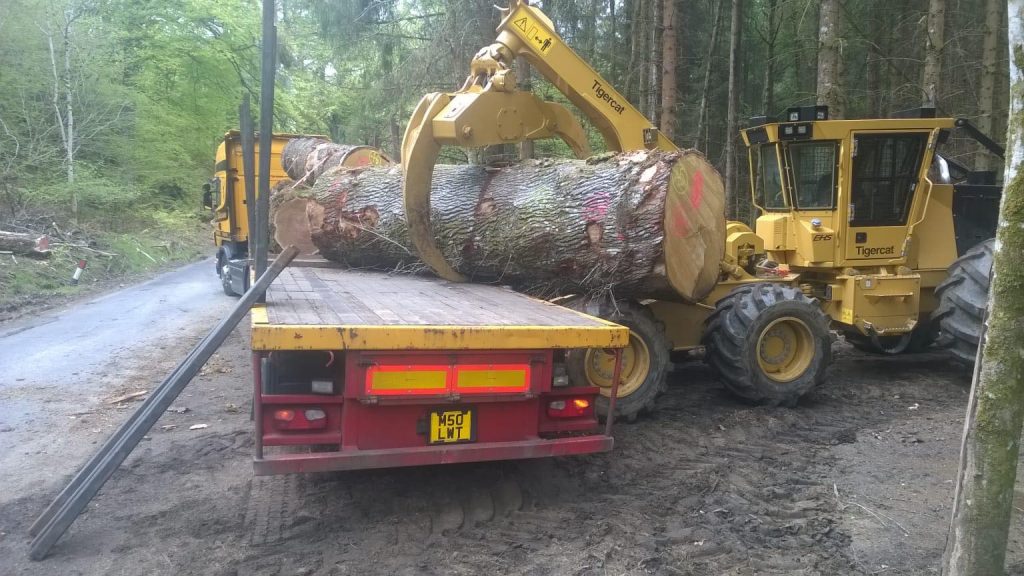

His client base also extends to the film company which produces the Outlander series. He carries out any tree work required to avoid accidents during filming and adds lighting onto trees when required by the camera crew.
I felt we had held up Willie for long enough, but I was hoping for a go in the Komatsu 895 with the Comfort Ride before we left. I had never used one before and wanted to see whether the difference was worth the extra cost. Having taken it for a spin, I can definitely say it is an worthwhile addition and demonstrably improves operator comfort by reducing vibration and jolts.
The underlying construction of the new Comfort Ride Cab consists of two frames, one on top of the other. There are hydraulic cylinders between the frames that are fitted with integrated remote position sensors to keep the cab in the centre position. This creates a four-point suspension that allows long and free movements in the suspension. Moreover, the cylinders’ long travel allows the suspension to absorb more energy, reducing the chance of the cylinders bottoming out.
The large support area created by the four-point suspension also provides good damping, which results in gentler rocking movements compared to a three-point suspension. A hydraulic stabiliser prevents the cab from excessive side-to-side rolling, while a Ride Height Control function compensates movements so that the cab is always in the centre of the cylinders regardless of any shift in the cab’s centre of gravity. The operator can press a button to raise the cab to the cylinders’ highest position, which is helpful when unloading the forwarder as it provides a better view of the bunk.
Willie has also had a full width front logging blade fitted and opted for the adjustable wider loading bunks. For a big forwarder, it was quite nimble and the crane was smooth, precise, and powerful. This was just the tonic I needed after being cooped up for so long during Covid-19.
If you are looking for a tree surgeon, someone to recover bogged or overturned equipment or have large hardwoods or softwoods that need felling and extracting please give Willie a call.
Home 01796482323 | Mobile 07771928812
Forest Machine Magazine is written and edited by a forest professional with over 40 years hands on experience. We are dedicated to keeping you informed with all the latest news, views and reviews from our industry.
To support us you can subscribe to our bi-monthly magazine which is delivered to your door from only £30 per year.
Subscribe here

